Home of Arizona Brevets and Long Distance Cycling
| Blogs 2007 |
|
Rinse, Cycle, Rinse – PBP 2007
This edition highlighted some of the unexpected advantages, yes advantages, of having rain and cooler temperatures on a long ride. Surely there is considerably less fluid consumption required and there is little worry about getting sunburn while wearing a jacket and tights for the entire ride. Another advantage is that there is less sleepiness due to the cooler temperatures. Usually the lazy, warm afternoon on the return from Brest has led to bouts of sleepiness in past years. No such problem this time as it was possible to do the entire ride without any shuteye. One big advantage was the elimination of hot, complaining, swollen feet usually expected during the last 400 km. The cooler temperatures helped avoid this malady as well as mercifully helped reduce saddle soreness. I'm now a firm believer in using Balmex to reduce saddle soreness and this time it performed double duty as an effective water repellent. Going into PBP fully expecting heavy rain meant that when it actually started, it was simply a matter of putting on the rain gear and not really giving it a second thought. Focusing on the positives of riding in the rain as mentioned, along with the novelty of it all, coming from the scorching hot desert, are what make PBP unique and a much anticipated event. The physical and mechanical challenges of PBP were greatly reduced for me this time as this was the most trouble free of my PBPs. In every past ride there were significant challenges that had to be overcome. Whether mechanical or physical, they were a real threat to completion of the ride. While there were issues this time, they were managed and kept in the background. An upset stomach from Loudeac to past Brest from bad food didn't overshadow some the highlights of this stretch, like riding with several of the Seattle Randonneurs, including Mark Thomas, who recalled riding the Tombstone 600k brevet with us and recounted spending the previous night near Carhaix in a bed and breakfast not far from the route. This sounded like it might be a worth considering for 2011. One unfortunate change noted and confirmed by 5000 km of travel around France after PBP was the noticeable increase in the car traffic on all roads. It seems to be an increase of maybe 10% over four years ago. Accompanying this rise was an increase in unfriendly bike-car encounters seen on the PBP route. One of the highlights of PBP has always been the feeling of actually belonging on the roads of France. In Provence there were some rond-points and rural roads with 'no bikes allowed' signs. It was also disheartening to note that the number of motorcycles and scooters have seemingly doubled in just a few years, ostensibly at the expense of bicycles. Across France many former bike shops were seen that had been either mainly or completely converted to motorcycle sales. Cycles Peugeot shops now sell motorcycles, since Peugeot no longer makes bikes. It would seem that all of this might portend a future reduction in PBP participation, at least amongst the French, and a decline in the wonderful, unique role that bicycles enjoy in France. But it was also noted that one recent cyclotourisme event in France had over 7500 entrants and the highly regarded l'Ardechoise had 12,500 riders! Hopefully this indicates that interest in cycling in France has really not changed for the worse at all. Several of the legs were run off as much as an hour slower than planned. In several of the slower legs the reason was that I was enjoying riding and talking with a variety of riders. Especially fun was riding with James Williams of North Carolina and Robin Piper of the Seattle Randonneurs from Mortagne, through Dreux, to the finish. We also had an 80 hour rider on a single speed with us who often stopped due to the climbing effort. We kept each other entertained the entire way, and since we rode at a very comfortable pace, the desire to push for time over the last 120 km, which would have made the final legs significantly less enjoyable, was negated. Riding with a group over the last 55 km, 25 of which were added in 2003 as "bonus", primarily climbing, kilometers, made them melt away. It also helped to have others around as we entered one village about 25 km after Dreux that had no signs posted at an intersection. A dozen of us had no idea which way to proceed until a volunteer drove up and gave us the direction to follow. It seemed that there were significantly lless signs posted on the route this time than in 2003. Pushing for a faster time would have made the trip back from Brest considerably less enjoyable. The tradeoff was exchanging a finishing time in the upper 60 hour range for the calculated one, which had been in the lower 60 hour range. It's not much of a tradeoff really as I had a very easy passage, highlighted by many hours of joyful riding in one of the best riding spots on Earth.
While the climbing was enjoyable this time, there remains the observation that the course selection seemed to include climbs simply for climb's sake. An example was the return to Fougeres from Tinteniac at the rond point approaching the southwest of Fougeres, from which it is only a short distance to the control. Instead of heading straight to the control, the route headed up to the north of town to retrace the steepest climb in Fougeres, also used on the outbound route, before heading back down hill to the control. I would rather that the route went from the rond point up to the incredible medieval castle of Fougeres and on to the control. Having the route pass by the castle has not been included since 1987 and it would be a great sight for riders to see. The two days before PBP commences are usually spent taking short rides out on the route to check out the bike assembly and relax. This time no riding was done for fear of crashing and jeopardizing making it to the start intact. Several riders did in fact crash in the days before the start in simple falls that kept them from starting. The distinct disadvantage in not riding was a sense of despondency that was especially troublesome the two nights before the start. Even short rides during those two days would have released enough endorphins to provide some mental benefits. Once the ride began, however, all of the worries and doubts disappeared as now I was doing something I knew how to do – ride my bike in PBP. A lesson to be remembered for future rides. One piece on equipment that was a disappointment was the Gore-Tex rain jacket bought especially for PBP and first used in 1987. In the heavy rain leg from Loudeac to Tinteniac it became apparent that the inside of the jacket was as wet as the rain soaked outside, so it was only functioning as a wind breaker. During this stretch I had the good fortune to ride with an excellent and kind French rider. We hooked up leaving Loudeac as it was obvious he wanted to have someone to ride with on this nighttime section as we headed out into the rain. We knocked out the stretch to the secret control at a solid pace in the heavy rain. A couple of times I drifted back from him and he very considerately dropped his pace, which I responded to by accelerating back up to him so we could continue on together. We never spoke, but were definitely thinking and riding with a common goal. While there were really none of the usual ride threatening physical or mechanical challenges this time, PBP remains my favorite cycling challenge, with its rich history and unique flavor. While completing 10 PBPs is still a goal, it will only happen with more good luck like I enjoyed during the 2007 PBP. |
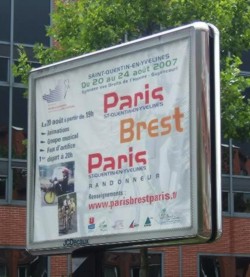 The 2007 edition of Paris Brest Paris certainly offered a different set of weather challenges than its last four outings in the Bretagne region of France. The abandonment rate of around 30% was a reflection of a ride that many were not planning for. Most accounts to be written will undoubtedly point to the rain and cold encountered in this the world's oldest organized bicycle event. My perception of this edition is probably considerably different than that of most riders, for this was the easiest of the six PBPs I've ridden. There were a number of reasons for the relative ease of PBP in 2007.
The 2007 edition of Paris Brest Paris certainly offered a different set of weather challenges than its last four outings in the Bretagne region of France. The abandonment rate of around 30% was a reflection of a ride that many were not planning for. Most accounts to be written will undoubtedly point to the rain and cold encountered in this the world's oldest organized bicycle event. My perception of this edition is probably considerably different than that of most riders, for this was the easiest of the six PBPs I've ridden. There were a number of reasons for the relative ease of PBP in 2007.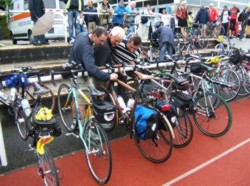 PBP is at least as much about preparing for the ride as actually riding from Paris to Brest and back. With all of the brevets, traveling and planning that go into this ride; it seems that 90% of the effort is completed even before reaching the starting line. Another 5% of the effort is simply making it safely through the white knuckle riding of the first 80 km. Not two kilometers after the start the rider directly in front of me crashed when he hit the small curb that separated the roadway from the sidewalk. My habit of riding at least a bike length behind the rider in front of me during the initial mad dash allowed for sufficient maneuvering space to avoid also visiting the pavement. Shortly after returning from France I suffered a crash due to a crank arm that snapped off while commuting to work. Had this happened a few days before leaving for France the outcome of PBP might have been considerably different. Luck is clearly a key ingredient in having one's name entered in the list of anciens.
PBP is at least as much about preparing for the ride as actually riding from Paris to Brest and back. With all of the brevets, traveling and planning that go into this ride; it seems that 90% of the effort is completed even before reaching the starting line. Another 5% of the effort is simply making it safely through the white knuckle riding of the first 80 km. Not two kilometers after the start the rider directly in front of me crashed when he hit the small curb that separated the roadway from the sidewalk. My habit of riding at least a bike length behind the rider in front of me during the initial mad dash allowed for sufficient maneuvering space to avoid also visiting the pavement. Shortly after returning from France I suffered a crash due to a crank arm that snapped off while commuting to work. Had this happened a few days before leaving for France the outcome of PBP might have been considerably different. Luck is clearly a key ingredient in having one's name entered in the list of anciens. 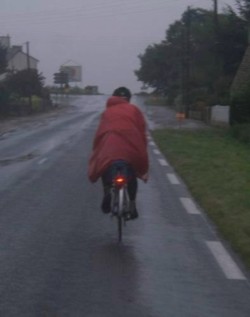 To properly prepare for PBP, I've found that it is essential to expect and plan for adverse weather, yet hope for the best. The PBP preparation presentation given at the Camp Verde brevet series included mention that since there hadn't been much rain since the heavy rains of 1987 we were long overdue for rain this year. For me this meant fenders and full rain gear were a given when preparing the equipment and clothing list. On the leg from Fougeres to Tinteniac I rode with Clyde Butt, who took the advice from Camp Verde and fitted fenders on his purple machine. He was riding at a good pace and quite thankful, albeit suffering with asthma, as I often do.
To properly prepare for PBP, I've found that it is essential to expect and plan for adverse weather, yet hope for the best. The PBP preparation presentation given at the Camp Verde brevet series included mention that since there hadn't been much rain since the heavy rains of 1987 we were long overdue for rain this year. For me this meant fenders and full rain gear were a given when preparing the equipment and clothing list. On the leg from Fougeres to Tinteniac I rode with Clyde Butt, who took the advice from Camp Verde and fitted fenders on his purple machine. He was riding at a good pace and quite thankful, albeit suffering with asthma, as I often do.
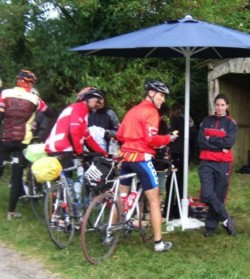 This edition also marked some changes from earlier outings. Typically it is fun to stop along the route and get water from the children who set up water stops. I like to give them American quarters as souvenirs. I didn't really see many water stops this time due the cold, but instead there were many stops set up to sell hot drinks by enterprising people who have now figured out that 5000 riders passing through their village can become a real money maker.
This edition also marked some changes from earlier outings. Typically it is fun to stop along the route and get water from the children who set up water stops. I like to give them American quarters as souvenirs. I didn't really see many water stops this time due the cold, but instead there were many stops set up to sell hot drinks by enterprising people who have now figured out that 5000 riders passing through their village can become a real money maker.
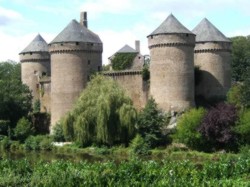 One conflict that always plays out at PBP is the desire to post a fast time versus riding at a slower pace and have a more rewarding experience from taking the time to enjoy the ride. The slower pace affords less risk of a physical ailment cropping up that might threaten completion of the ride, such as tendonitis, which seemed more probable given the lower temperatures this time. A slower time also permits more freedom to take pictures, ride at other rider's pace and talk to them and also time to stop and look around when something interesting presents itself. A faster time is primarily about the additional challenge and generating a statistic that affords a sense of pride.
One conflict that always plays out at PBP is the desire to post a fast time versus riding at a slower pace and have a more rewarding experience from taking the time to enjoy the ride. The slower pace affords less risk of a physical ailment cropping up that might threaten completion of the ride, such as tendonitis, which seemed more probable given the lower temperatures this time. A slower time also permits more freedom to take pictures, ride at other rider's pace and talk to them and also time to stop and look around when something interesting presents itself. A faster time is primarily about the additional challenge and generating a statistic that affords a sense of pride.
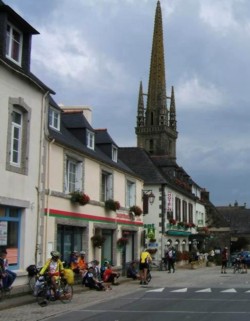 The strategy used to try and address this conflict involved developing a time schedule in advance of the ride with time splits for each leg based on reach out goals over previous best times. Riding to this schedule from the start puts into play the fast time approach. As the ride progresses, inevitably problems arise that unavoidably knock the effort off schedule. Then the transition to the slower time must be accepted and welcomed. Only then is it possible to more fully enjoy the benefits of the slower pace. Even so, with the time splits still available for review, it is still possible to do faster pace legs throughout the ride. It is, however, risky to try and recover lost time by pushing the pace. So it becomes a tradeoff between a little disappointment in not meeting the fast time goal balanced against more experiences encountered at the slower pace. There was a nice balance this time as several of the legs were run off within minutes of the reach out goal times without having to ride uncomfortably fast.
The strategy used to try and address this conflict involved developing a time schedule in advance of the ride with time splits for each leg based on reach out goals over previous best times. Riding to this schedule from the start puts into play the fast time approach. As the ride progresses, inevitably problems arise that unavoidably knock the effort off schedule. Then the transition to the slower time must be accepted and welcomed. Only then is it possible to more fully enjoy the benefits of the slower pace. Even so, with the time splits still available for review, it is still possible to do faster pace legs throughout the ride. It is, however, risky to try and recover lost time by pushing the pace. So it becomes a tradeoff between a little disappointment in not meeting the fast time goal balanced against more experiences encountered at the slower pace. There was a nice balance this time as several of the legs were run off within minutes of the reach out goal times without having to ride uncomfortably fast.
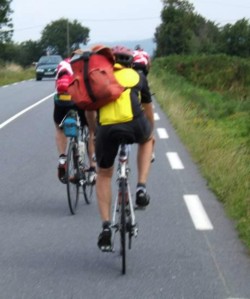 One other pleasant aspect of this ride was that riding at a comfortable pace well within my fitness level made both the physical and mental aspects of the ride less stressful. The training regimen used in July and August with heavy emphasis on hard climbing meant that all 10,000 m of climbing were hardly even noticed as I spent most of the distance in the company of other riders.
One other pleasant aspect of this ride was that riding at a comfortable pace well within my fitness level made both the physical and mental aspects of the ride less stressful. The training regimen used in July and August with heavy emphasis on hard climbing meant that all 10,000 m of climbing were hardly even noticed as I spent most of the distance in the company of other riders.
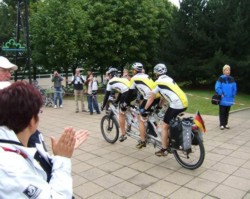 Surprisingly I found that the record number of riders in 2007 was an advantage. There were always plenty of riders around to ride with, which was most welcome at night. Riding solo was a rarity this time. It has become especially easy to find English speaking riders on the route as English has really become the second language of the ride. Years ago this was hardly the case. I still enjoy making the effort to conduct all my business at the controls in French, but having English spoken while riding makes for a considerable savings in mental effort. The large number of riders did not mean long lines at the controls. The only time large numbers were seen was during the outbound Loudeac stop at night where the dining room was filled with sleeping riders at the tables and on the floor, which made it difficult to find a place to sit and eat.
Surprisingly I found that the record number of riders in 2007 was an advantage. There were always plenty of riders around to ride with, which was most welcome at night. Riding solo was a rarity this time. It has become especially easy to find English speaking riders on the route as English has really become the second language of the ride. Years ago this was hardly the case. I still enjoy making the effort to conduct all my business at the controls in French, but having English spoken while riding makes for a considerable savings in mental effort. The large number of riders did not mean long lines at the controls. The only time large numbers were seen was during the outbound Loudeac stop at night where the dining room was filled with sleeping riders at the tables and on the floor, which made it difficult to find a place to sit and eat.